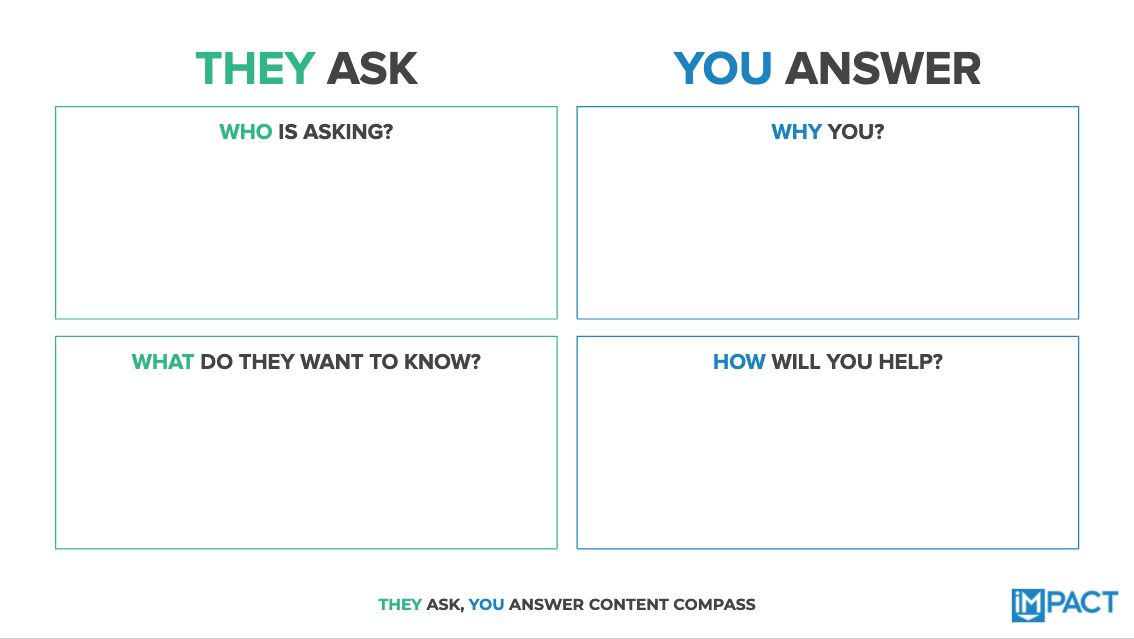Join 40,000+ sales and marketing pros who receive our weekly newsletter.
Get the most relevant, actionable digital sales and marketing insights you need to make smarter decisions faster... all in under five minutes.
How to write a blog
- Choose your topic
- Identify the who for your blog article
- Document what your audience wants from you in this blog article
- Determine why you're the #1 resource to be addressing this topic
- List out exactly how you're going to help them through what you're going to cover
- Choose one of the six introduction formulas for your blog
- Write the body of your blog so it's accurate, honest, thorough, and memorable
- Finally, close out your blog by answering one of the three conclusion questions
- Give yourself a high-five!
If you're here, you fall into one of the following categories:
- You're a digital marketer or a content manager for a company who has been tasked with writing and publishing money-making blog articles, as part of a larger content marketing or digital marketing strategy.
- You're a wayward subject matter expert or sales pro who has been asked by the aforementioned digital marketer or content manager into writing a piece of content, because you're the #1 resource about a particular topic.
- You're a business leader/owner or solopreneur who is rolling up their sleeves and getting their hands dirty with content marketing.
No matter which one of those you fall into, all of you have one thing in common. You know that you need to be creating content, but you need an explicit, easy, repeatable process for creating revenue-generating blog content that makes money for your brand.
In short, you need to know how to write a blog.
👉 Free course: Assignment selling and content as your greatest sales tool
Well, I have some good news for you! This article is going to lay out, step-by-step, how to write a blog article, so you can say goodbye to writer's block forever. I will also be giving you two crazy powerful content planning tools to help you do it.
Sounds pretty sweet, right? OK, let's dive in.
1. Choose your blog content topic
In an ideal world, you'd do the following:
You'd create a documented content strategy that includes an editorial content calendar filled with The Big 5 blog topics.
(Generally, your content strategy would also include room for pillar content, video for sales and marketing, and so on... but for the purposes of today's article, we're just focusing on the blog stuff!)
But let's say that's not the case. Let's say, you're still working toward getting that content strategy pulled together. So, your first step is to choose what you're writing about.
Since your time is valuable, you should focus first on the topics that will drive the most money:
- Pricing and cost
- Problems
- Comparisons
- Reviews
- "Best of" or "best in class"
We lovingly refer to these topics as The Big 5 blog topics, as our most successful clients have proven time and again that they are the blog topics guaranteed to drive the most traffic, leads, and sales for a company.
👉 Free course: 6 blog content topics guaranteed to drive revenue
If you're struggling to narrow down a topic from those categories, here are some prompts to help you get started:
Pricing and cost
-
“How Much Does X Cost?”
-
"What Factors Influence the Cost of X?"
-
“The X Hidden Costs of Y You Need to Know About”
-
“How to Reduce the Cost of X”
-
“How to Get the Best Price for X”
-
“How Much You Should Expect to Pay for X”
-
“How Much Should You Be Charging for X?”
Problems
-
The most common (and/or unexpected) problems with a product, service, etc., and how to avoid them.
-
"The X Problems with Y You're Likely to Miss"
-
"Why Is X Not Working & What Can I Do About It?"
- "What Do I Do If X Breaks/Gets Dirty/Etc.?"
-
If you sell different services and products, provide candid analysis specifically of the problems with each product type that someone might experience.
-
If you provide more B2B or consulting services, write about the problems someone might experience with similar services or service providers. Or barriers to success that might prevent them from seeing the results they expect.
-
"The X Reasons Why Y Fails/Breaks/Etc.," which works for both products and service-based relationships.
-
"X Reasons Why Y Isn't the Right Choice for You"
👉 Free course: How to build a content strategy in the digital age
Comparisons
-
Comparisons of common platforms used within your industry. (Example)
-
Comparisons of different types of solutions to the same problem.
-
Compare different types of service providers in your space. (Example)
-
Yesterday vs. today #1, "What solutions worked X years/decades ago but don't work today? What changed?"
-
Yesterday vs. today #2, "What problems were problems X years/decades ago but aren't anymore? Why?"
Reviews and "best" topics
Look, reviews are reviews, OK? Write them and be 100% honest and thorough in them. That's really all you need to do to get those right.
So, with that in mind, here are the prompts you need for your "best in class" or "best of" blog articles...
-
"The X Best [Your Company Type]" (Example)
-
“X Best Y in Z Location”
-
“X Best Types of Y”
-
“X Best Examples of Y & Why We Love Them”
-
Best tools to help someone do their job better. (Example)
-
Best solutions, products, or tools to solve a particular problem.
🔎 Related: But how am I supposed to write about our competitors?
OK, now that you've gotten your topic, now it's time to move onto the next step, which is planning out your piece of content.
2. Create your blog content plan before you start writing, so you don't succumb to writer's block
OK, the blog content planning (or outlining) process I'm about to teach you will cut the amount of time you spend creating content in half.
Meet the They Ask, You Answer Content Compass:
They Ask, You Answer Content Compass (Google Docs, make a copy to use)
They Ask, You Answer Content Compass (downloadable PDF)
It looks deceptively simple, I know.
But before I can teach you how (and why) it's so insanely powerful, I need to explain what problem is solves for.
Why do you need a content plan?
So, here's the deal:
The best content — you know, the kind that makes money — should be used in the sales process (through assignment selling) to better educate your ideal buyers, so you can close more deals faster.
👉 Pro course: Cure writer's block FOREVER in under 90 minutes with the subject matter expert's guide to content
Bottom line, not only do you not want the content creation process itself to be painful and time-consuming, you also don't want to create content that... well, sucks.
Otherwise you're just wasting your time, right?
The first step is admitting you have a bad content problem
The content topic you choose, as we discussed in the first step, will almost always be a question your ideal buyer has, pertaining to a product or service you sell. Unfortunately, there is such a thing as answering a question with a bad answer.
But sometimes you may not realize what that bad answer looks like. In my experience, here are the three most common ways bad answers happen to good, well-meaning content creators:
- You have the right answer, but you fail to address the underlying fears or problems of your intended audience in their words, so you never build the trust necessary to get them to listen.
- Because you’re so excited to be helpful or sell, you answer the question you want to answer, rather than the question that’s actually right in front of you, which can make you seem out of touch or like a politician who is only interested in advancing your own agenda.
- OR, worst of all, you give a bunch of information that technically answers the question, but it’s too broadly or narrowly scoped, so someone leaves feeling either overwhelmed and confused, or… underwhelmed and still confused.
How the Content Compass solves for this problem
The Content Compass — a 30-minutes-or-less exercise prevents you from falling into any of those three traps by mentally orienting you in the right direction before you take off "at full speed" in writing your blog article.
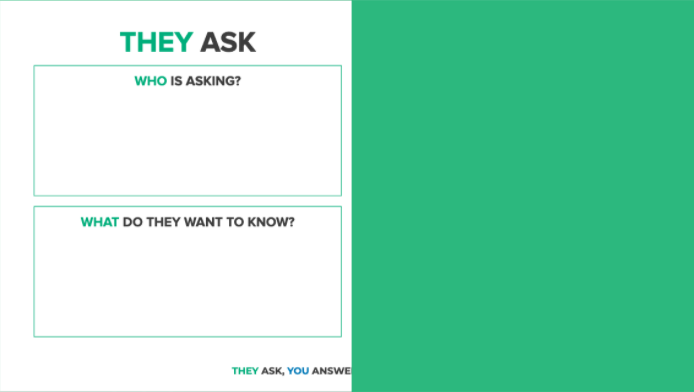
At a high level, the Content Compass will empower you to quickly develop a deep understanding of WHO is asking the question and WHAT exactly what they need from you...

...which will enable you to know exactly WHY you’re #1 teacher on that specific topic (as well as what exactly from your background you need to share with them), as well as HOW exactly you’re going to help them.
But only if you answer each question in the Content Compass in a specific order — WHO, WHAT, WHY, and HOW — and in the exact way I’m about to show you.
First, you need to answer WHO
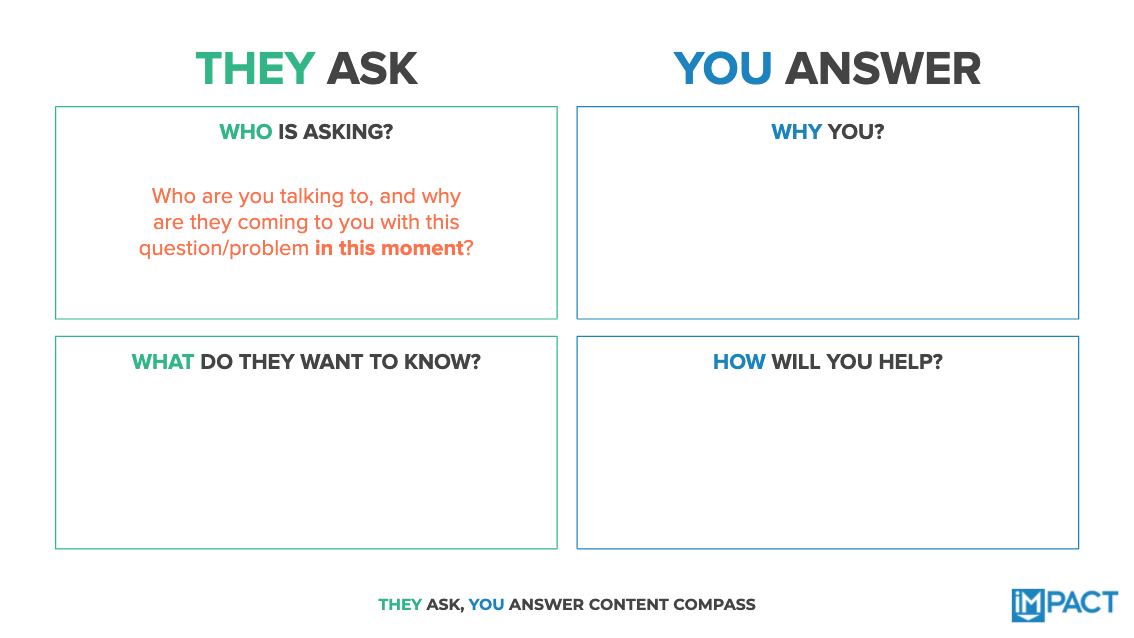
The goal of answering this question is not just to get the basics about the ideal buyer you’re talking to -- like their job title, role, and so on -- although those are very important too.
You want to define and document very explicitly how they are feeling as they ask the question. So, beyond the basics, ask yourself:
Why do they care about this topic right now? How do they feel about it? Are they asking because they’re likely stressed or there’s some sort of external factor that’s creating a fear or pain that they’re trying to remove?
Are they trying to achieve a goal? If so, is it their goal, or did a boss, peer, or loved one come up and say:
"Hi, I have this goal and it’s your goal now. Figure it out."
Are they feeling any sort of pressure at all? If so from who or where? Above, below, at a peer level? All three?
Bottom line, your buyers are almost always looking to you to remove a pain or solve a problem because they are unable to do it themselves. They don’t want to hear about your big ideas or sparkly solutions, on your terms. They want to be seen and heard and understood, and they want you to help them.
And you can only do that by answering this question thoroughly.
Second, you need to answer WHAT
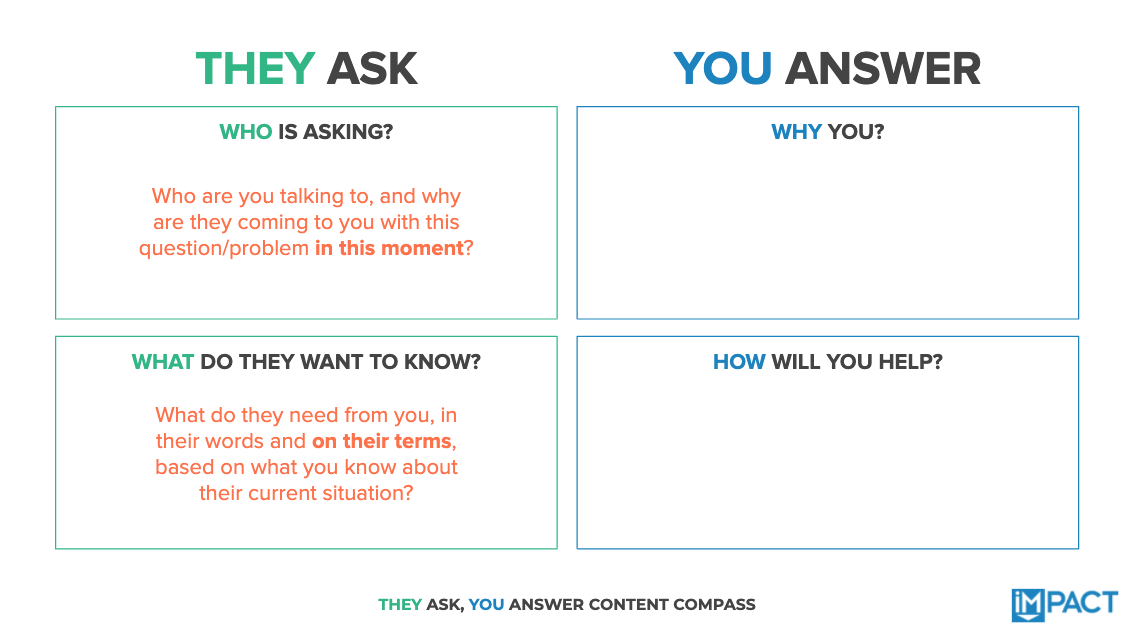
How would they phrase the question to you in their words? What follow-up questions will they have? What objections or resistance might they express to you and in what order?
Have that imaginary conversation in your head, but completely ignore the responses you give them. Focus solely on what it is they would say to you.
Again, in their words.
So close your eyes — literally close your eyes. Imagine they are sitting there in front of you, and LISTEN to them.
It sounds a little abstract, I know.
So, to help you out, let’s take a look at a world-class answer to this WHAT question using an example by IMPACT Paid Media Specialist Dan Baum, who used this tool to help plan out his article on how much Google Ads cost (pricing and budgets):
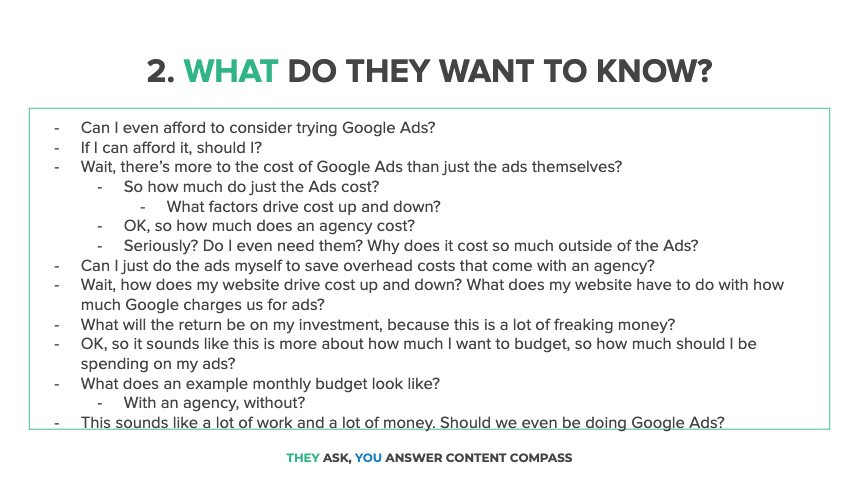
As you can see in the above example, the output of this section should be a one-sided conversation, where you’re ONLY documenting the questions and challenges you know this ideal buyer will ask you about your question.
That looks like a lot, right? Well, guess what? It only took Dan and I five minutes to get that onto paper. And it’ll be the same way for you if you answered that WHO question appropriately.
Third, you need to answer WHY
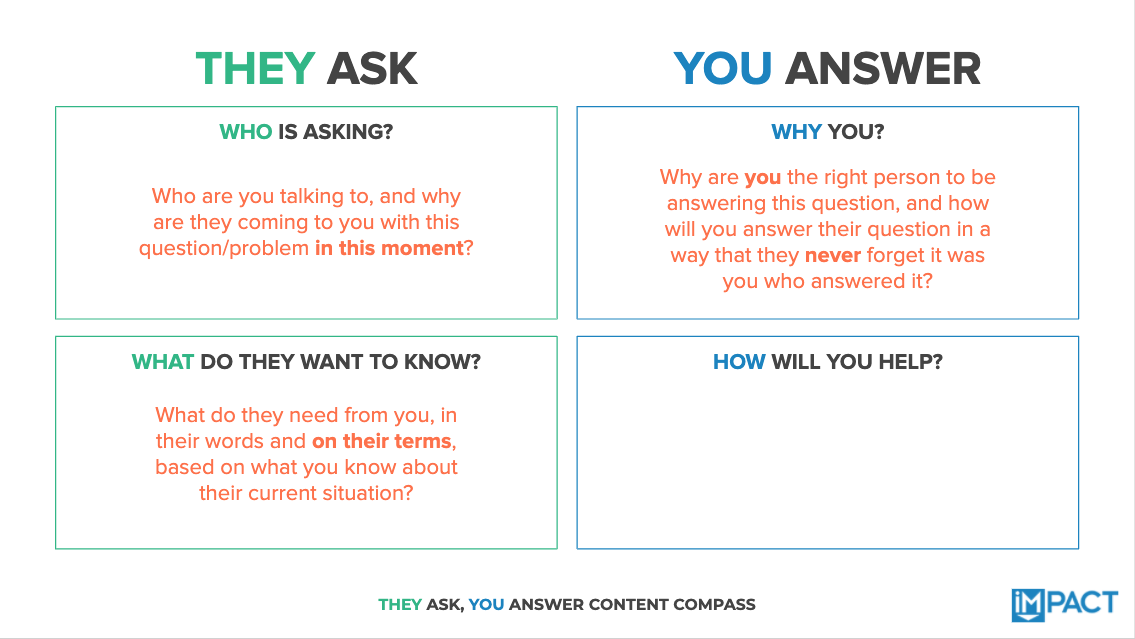
Think about it — this virtual ideal buyer has never met you before. That means, through your content, you will somehow need to establish very quickly that you can be trusted as the best resource to address the answer a specific question for them.
What they’re saying here to you is, Why should I trust that you’re the one to help me with this specific question?”
Is it the breadth and depth of your experience in a particular area? Have you been a seasoned expert in your field for a long time? Have you helped tons of people just like them? What are the specific-to-you stories, anecdotes, and experiences that relate to the question you’re answering?
Have you ever been them or been in their shoes? Do you know exactly how they feel right now?
Let's take a look at two examples from two different articles — Dan's Google Ads cost article and my content manager problems article — of how you might answer this question, as your answer will fall into one of two buckets:
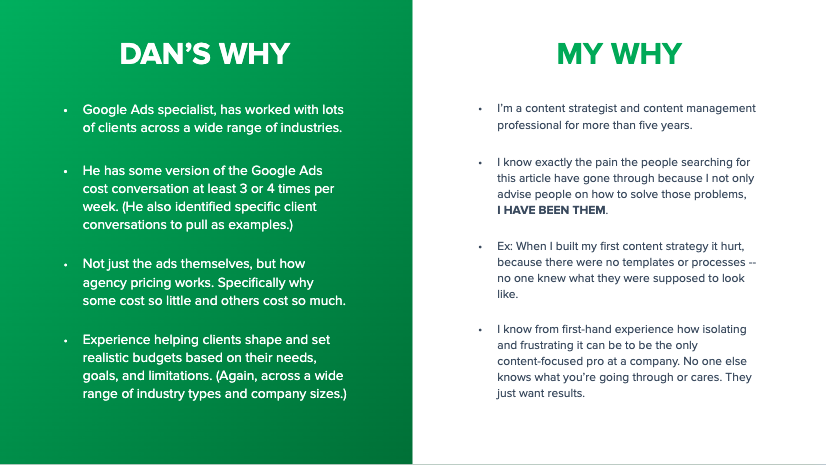
In Dan’s case, his WHY is pretty straightforward. Google Ads are his job and he’s been doing it for awhile. Moreover, he’s answered this question a thousand times, and has some form of that conversation every single day.
It’s not about one story OR the fact that he’s ever been the person asking this question, but rather a summary of experiences wherein he’s found himself addressing this question a lot because he is a subject matter expert.
In short, the bottom line here is he’s saying:
"I am the expert who has helped tons of people just like you. That's why I am the right person to help you."
In my case, however, it’s the opposite. Yes, I’m an expert in content strategy and creation, but this is a very personal topic for me because I have been in the exact same shoes as my audience.
I have been the frustrated, isolated, and confused content manager pulling my hair out trying to solve problems no one else had solutions for yet.
In fact, there was one night that jumped out at me as I answered the WHY ME question — wherein I was up until 4 a.m., on the verge of tears, trying to put a content strategy together and I didn’t know how. Back then what I did was so new, there were no templates, rules, or standards to follow.
In short, the bottom line is that I’m saying with my WHY:
"I am not only an expert, I have been you. I know what you are going through and I know how to solve your problems. That's why I am the right person to help you."
Your answer to WHY will likely fall into one of those two buckets and will help you know what (if any) stories you need to bring in, as well as how you may want to weave personal storytelling into your blog article.
Finally, you need to answer HOW
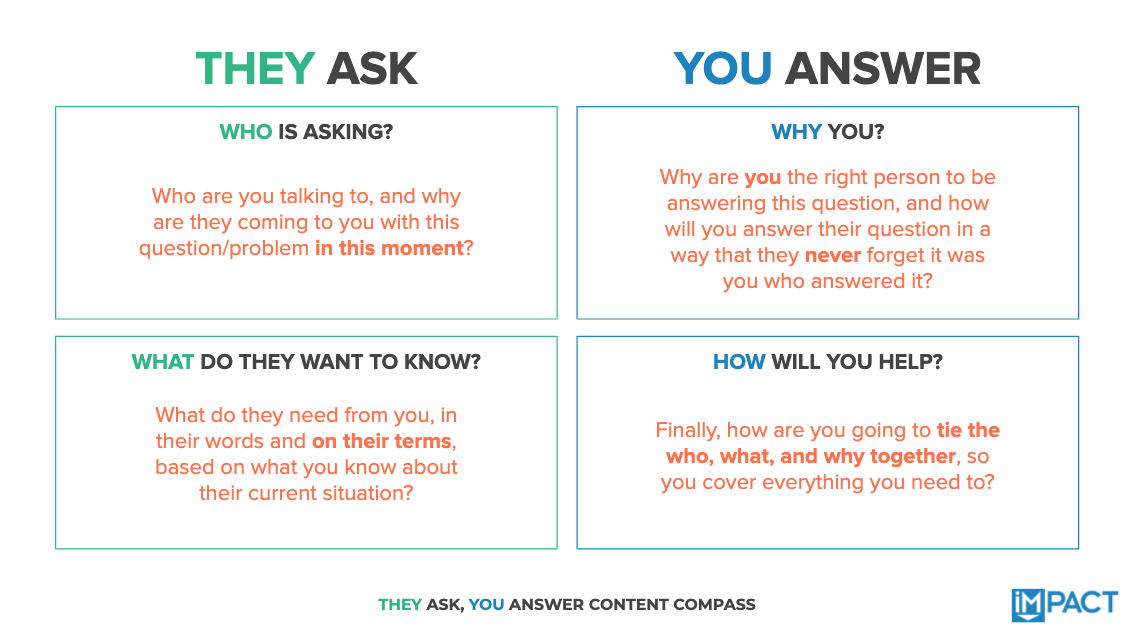
Now that you know who you’re talking to and why, what they want to know from you specifically, and why you’re the one to answer their question, how are you going to help them in your content?
Whenever I coach people on how to answer this question, I tell them you are NOT creating an outline. Instead the goal here is to create a super loose table of contents. “Now that I know who, what, and why, what are the basic things I need to cover and in what basic order?”
Going back to Dan's example, here's what he put down for his:
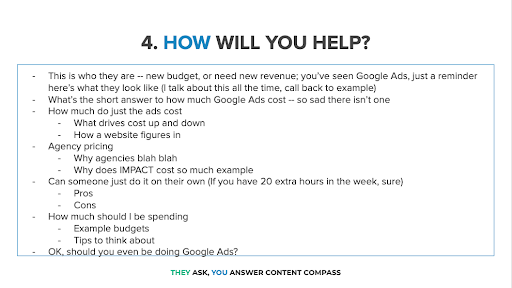
From here, you can go straight to writing, or you can use this loose table of contents as the start of your outline!
3. Write your blog post introduction
Next, it's time to write your introduction. Every introduction, no matter how long or short, or what your article is about, needs to answer three questions for your audience:
- "Is this article for me?"
- "Is this article about the problem or question I'm trying to answer?"
- "How are you going to help me?"
I have six tried-and-true blog introduction formulas I always stick with:
- Lead with a compelling, sourced statistic that ties directly into your article.
- Open with a personal story, the way I did with my content managers problems article.
- Tell a hypothetical story that paints the picture for the person who is reading the article. For example, "Molly is a subject matter expert, and she's stressed out. She has to write a blog article for her marketing team. Yes, she's an expert on the topic, but writing isn't exactly her favorite thing to do..." See what I mean?
- Or, tell their story... the exact way I did at the start of this very article. Explicitly call out who they are, what they want, and why they're here.
- Ask the audience a question. "Have you ever struggled to write a blog introduction? Well, you're not alone."
- Stir the pot with a controversial opinion... which is then backed up by facts or research or your experience. Without facts, research, or experience, you're just being a jerk.
4. Now, it's time to write the meat and potatoes of your blog
OK, this is where it gets tricky, because what goes into the meat of your article will depend on what you're writing. That being said, if you did the HOW part of your Content Compass correctly in step two, you'll know exactly what needs to go here.
Moreover, no matter what you're writing about, remember that the best blog articles are:
- Accurate
- Thorough
- Honest
- Memorable
Thoroughness is one area where people get a little tripped up on, so I always recommend making sure to include as many visual examples as possible. If you're teaching someone a process and you can show it, do it.
In terms of being memorable, just be yourself. Tell your stories, use a conversational tone, and make it so no one else could have written that article but you.
5. Finally, wrap that bad boy up with a nice little conclusion bow
Conclusions are really hard, but they don't have to be. There are three things you don't want to do with your conclusion:
- Do what your grade school teachers told you and just... restate your thesis and everything you just said.
- Skip over writing a conclusion entirely, simply ending on your blog with the last point or item, if it's a list-based article.
- Ending with one of those garbage, attention-seeking, "Hey, comment with your answer to this poorly-masked cry for help question!"
Conclusions to business blog articles should inspire people, excite them for what's next, and make them want to take action. So, doing any of those three things is a one-way ticket to Snoozeville, rather than Actiontown.
So, here's what you do instead for conclusions
Once I get to the end of my last paragraph, when I'm ready to wow you with all that my brain has to offer, I imagine the reader sitting across from me, and I wait for them to ask me one of the following three questions:
"So What?"
"Why should I care about this? I mean, what you're saying makes sense, but so what? What does this mean for me? For my business? Why should I care?"
"Why Now?"
"Look, what you're saying sounds great, in theory. But I don't have time for this. Why should I make time for this right now? Why do I need to make changes to what's already working, what's easy, and what's comfortable in this very moment? What's the urgency? Are there any real consequences to inaction? Can't I just wait a little longer, when I have more time, more money, more people?"
"OK, What's Next?"
"Buddy, I am with you. I'm hooked, I'm in. But uh... what am I supposed to do? I'm excited, but I have no clue where to start. You gave me this huge, overwhelming laundry list of things, and I need you to give me that nudge in the right direction. What's the first baby step I can take to get me going on my big journey?"
When I'm ready to write the conclusion, I'll pause and ask myself, "Which one of these three questions is the most logical question a reader would ask me at this moment?"
Then, I write the answer. That's my conclusion.
Emergency Parachute: The "One Thing" Exercise
So, the above process works about 99.9% of the time.
But, if for some reason, you still get stuck -- it happens to the best of us -- here's what you should do:
Ask Yourself:
"If my audience has the brain of a heavily-concussed goldfish, and they only walk away remembering one thing from this blog article, what should it be and why?"
Your answer is your conclusion.
"OK, Liz, that's a lot... how am I going to remember this?"
I am so glad you asked. Keeping tracking of all of these different moving pieces is tough. That's why I created this free blog post template to help you run through this process every single time — along with a few extra steps on keyword optimization and other bells and whistles you may need.
Also, if you're like me, you like to have examples at your fingertips, so you know what you should be working toward. So, recently, I put together this list of 24 world-class blog post examples that perfectly capture the principles and best practices I shared in this article.
Of course, if you have questions, you can find me in the Content Managers section of the IMPACT+ discussion board. I'd be happy to chat more or provide feedback on your work!
Happy blogging!
Free Assessment:


